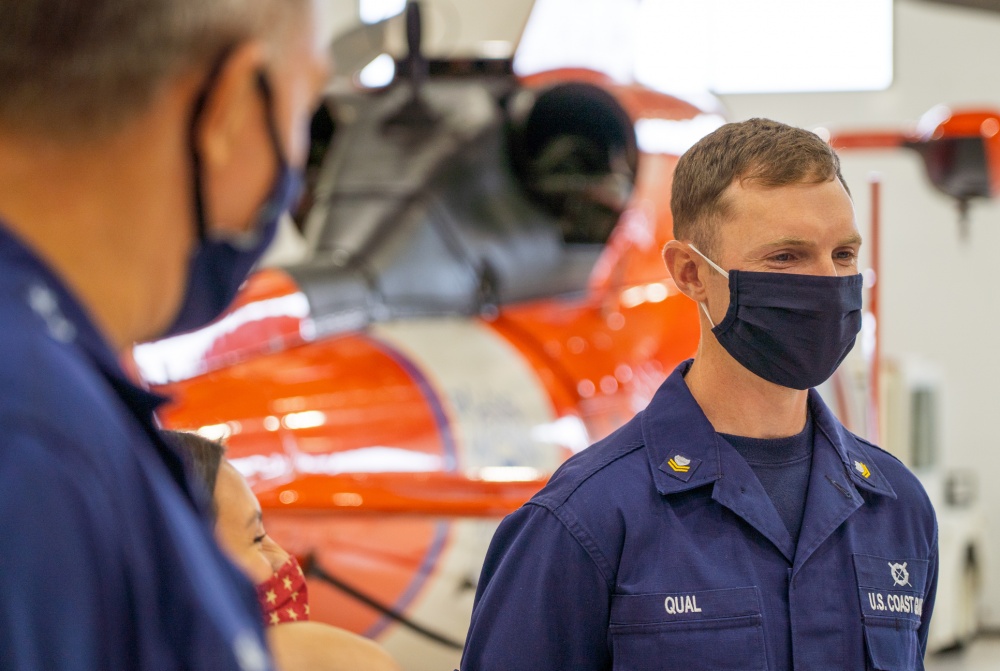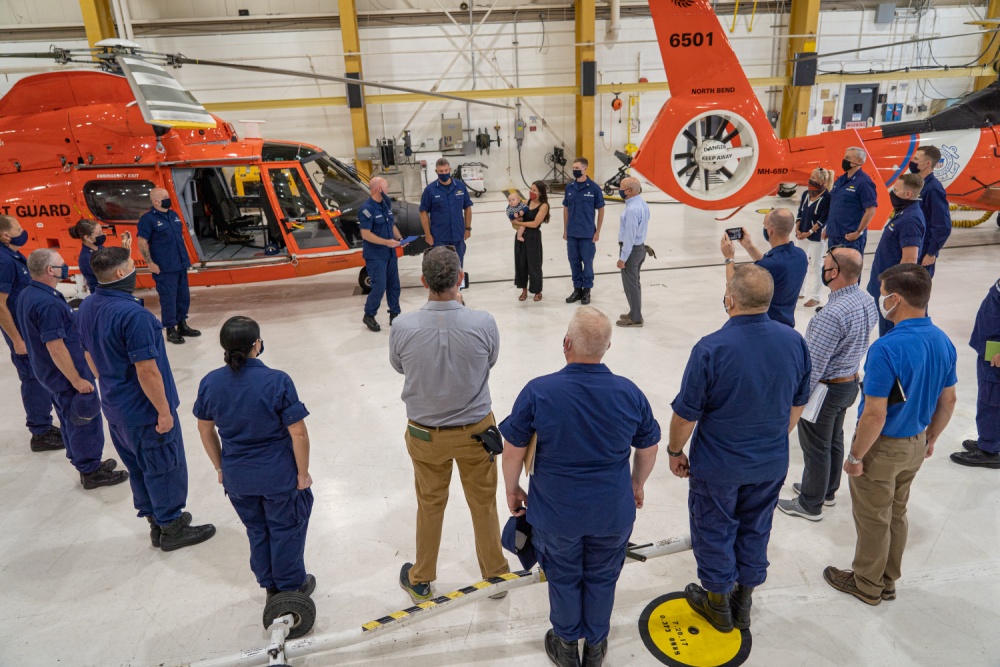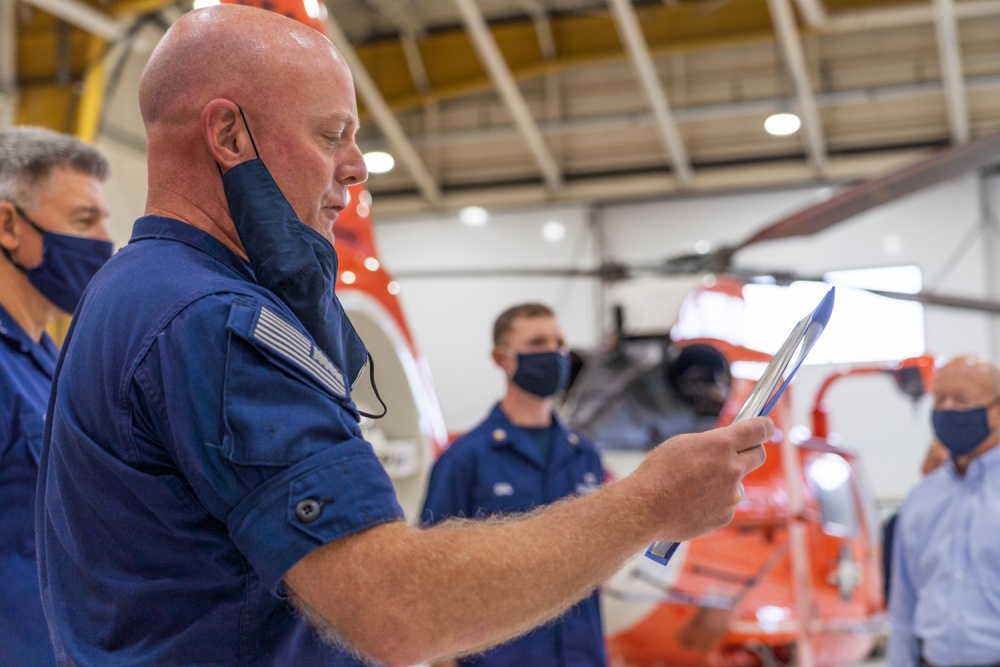If you work hard enough, you might have the opportunity to skip the service wide exam and still advance to the next pay grade. The Coast Guard has updated the Meritorious Advancement Program (MAP) providing members new opportunities to be recognized and advanced in the process.
“The Coast Guard's meritorious advancement program was in need of an overhaul after a couple years of gathering field feedback,” said Master Chief Petty Officer Shawn Swanson, Office of Military Policy and Standards. “With the help of the Master Chief Petty Officer of the Coast Guard and the Gold Badge network, we aimed to create an improved, streamlined program, which allows more people to be advanced in the field, and recognize talent in a rapid manner, anywhere across the Coast Guard. For the first time, we have enabled additional senior leaders to exercise authority to advance members for increased reach throughout the service.”
Wallace Qual, a boatswain’s mate from Coast Guard Station Yaquina Bay in Newport, Ore., who was also the recipient of the 2019 CDR Ray Evans Outstanding Coxswain Award, was a second class petty officer at breakfast and a first class petty officer by lunch thanks to an update to the MAP program. Qual received his meritorious advancement Aug. 20, 2020.
“I knew I was submitted for the 2019 CDR Ray Evans award but was totally surprised to receive the advancement,” Qual said. “It feels great to be recognized for my accomplishments, and my family was able to be there for the ceremony, which made the advancement even better!”
The new changes to the MAP provides Coast Guard members with an excellent opportunity to be recognized and advanced in the field. It also gives members an incentive to succeed in their positions, which benefits everyone in the Coast Guard.
The Meritorious Advancement Program (COMDT Instruction 1430.2) has been updated with the following changes:
- Advancement authority is extended to rear admirals at districts, FORCECOM, Personnel Service Center, Cyber Command, and Director of Operational Logistics.
- Advancement allocations are extended to both active duty and reserve members.
- Time in grade (TIG) is the only advancement eligibility requirement, all other advancement requirements are deferred.
- Once a member is identified for Meritorious Advancement, the only administrative action needed is a Memo to PPC
The Assistant Commandant for Human Resources, has special authority to authorize advancements without participation in the (SWE) competition or supplemental advancement lists. To increase opportunities to recognize top performers, limited meritorious advancement authority will be authorized to advance E-4 and E-5 paygrades only (for advancement to E-5 and E-6 respectively).
Why were the changes made?
MAP is designed to accommodate unique circumstances that, in the advancement authority’s judgment, clearly warrant advancement. The program’s intention is to provide a means to advance petty officers for compelling, although perhaps not quantifiable, reasons. Isolated acts of heroism or single specific achievements should not be the sole basis for advancement under the MAP, but may be the mechanism that illustrates consistent extraordinary performance.
Why is this change important?
The MAP is designed as a supplemental program to properly recognize and advance enlisted members and to be utilized in conjunction with other established award and recognition processes. Minimal increase in administrative process workload is expected, but no additional training is required. Members advanced through the MAP may request early permanent change of station with command endorsement. Otherwise, members advanced under the MAP will fulfil their original PCS orders.
The Office of Human Resources delegates limited advancement authority specifically under the MAP. Meritorious advancement is extended to both active duty and reserve members. The Commandant and Vice Commandant can meritoriously advance members at their discretion. Vice admirals are authorized to meritoriously advance up to three active duty members and three reserve members per calendar year. District commanders, FORCECOM, DOL, Cyber Command, and PSC rear admirals are authorized one active duty and one reserve meritorious advancement per calendar year.
Key Points:
- MAP is open to all active duty and reserve enlisted members who meet the following criteria:
- Must be in the pay grade of E-4 or E-5 at the time of meritorious advancement
- Must meet eligibility criteria for reenlistment;
- Must have satisfied time in grade (TIG) for advancement of the next higher pay grade. Note: If a member does not meet the TIG requirement, the meritorious advancement can be executed on the day the member meets that requirement;
- Must be fit for duty at the time of advancement;
- Must be in compliance with Weight and Body Fat Standards outlined in;
- Must not have declined advancement or voluntarily elected to be removed from an eligibility list within two years of proposed meritorious advancement;
- Must not be a high year tenure (HYT) candidate who has exceeded their professional growth point (PGP) year. For example, if a member is a HYT candidate, the effective date of the meritorious advancement must be prior to or on Dec. 31 of the year the member enters their PGP;
- Must not have been previously advanced meritoriously;
- If the member is in a frocked status for the next higher pay grade, the effective date of advancement for pay and benefits of the current frocked status can be executed on the date of the meritorious advancement;
- Reservists must be currently serving in SELRES or an active duty status and have no status change request outstanding, i.e., IRR, ISL, and ASL;
- MAP will not have designated time frames and can be enacted as needed throughout the year. However, maximum allotments are counted per calendar year.
 |
 |
| Adm. Karl Schultz, the commandant of the Coast Guard, informs Petty Officer 1st Class Wallace Qual he will be meritoriously advanced to petty officer 1st class at Coast Guard Sector North Bend August 20, 2020. In attendance to the advancement ceremony were Qual’s family, Master Chief Petty Officer Jason Vanderhaden, the master chief petty officer of the Coast Guard, and others. (U.S. Coast Guard photo by Petty Officer 2nd Class Travis Magee/Released) |
Adm. Karl Schultz, the commandant of the Coast Guard, Master Chief Petty Officer Jason Vanderhaden, the master chief petty officer of the Coast Guard, and others gather for an advancement ceremony at Coast Guard Sector North Bend August 20, 2020. Petty Officer 1st Class Wallace Qual was meritoriously advanced by Adm. Karl Schultz, the commandant of the Coast Guard, to petty officer 1st class. (U.S. Coast Guard photo by Petty Officer 2nd Class Travis Magee/Released) |
 |
 |
| Master Chief Petty Officer Jason Vanderhaden, the master chief petty officer of the Coast Guard, participates in an advancement ceremony for Petty Officer 1st Class Wallace Qual at Coast Guard Sector North Bend August 20, 2020. Qual was meritoriously advanced by Adm. Karl Schultz, the commandant of the Coast Guard, to petty officer 1st class. (U.S. Coast Guard photo by Petty Officer 2nd Class Travis Magee/Released) |
Petty Officer 1st Class Wallace Qual and his family pose with Master Chief Petty Officer Jason Vanderhaden, the master chief petty officer of the Coast Guard, Adm. Karl Schultz, the commandant of the Coast Guard, and others at Coast Guard Sector North Bend August 20, 2020. Qual was meritoriously advanced by Schultz to petty officer 1st class. (U.S. Coast Guard photo by Petty Officer 2nd Class Travis Magee/Released) |